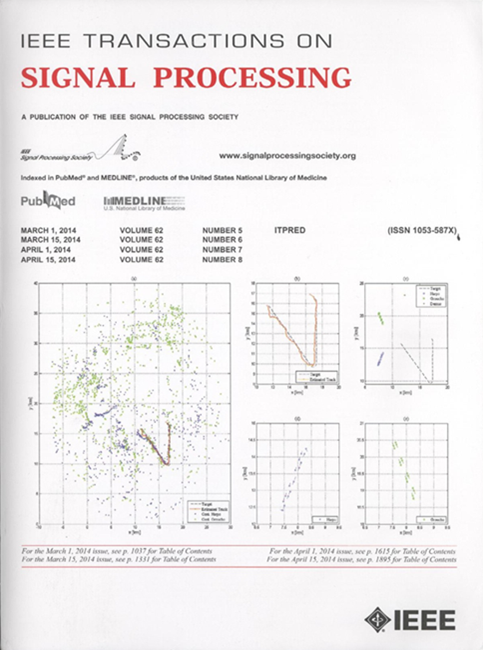多测量向量的无标记压缩感知
IF 5.8
2区 工程技术
Q1 ENGINEERING, ELECTRICAL & ELECTRONIC
引用次数: 0
摘要
本文介绍了一种求解多测量向量(MMV)无标记传感问题的算法。目标是从其嘈杂的线性观测矩阵$\boldsymbol{Y}$中恢复一个未知的结构化信号矩阵$\boldsymbol{X}$,其行被未知的排列矩阵$\boldsymbol{U}$进一步随机洗牌。在双线性向量近似消息传递(Bi-VAMP)框架的基础上,利用置换矩阵$\boldsymbol{U}$的行和列上的不可分离和耦合先验,提出了一种新的贝叶斯最优无标记压缩感知(UCS)恢复算法。特别是,标准无标记感知是所提出框架的特殊情况,UCS进一步推广了它,既不假设部分洗牌的信号矩阵$\boldsymbol{X}$,也不假设小尺寸的排列矩阵$\boldsymbol{U}$。为了理论性能预测,我们还对所提出的算法进行了状态演化(SE)分析,并证明了其与渐近经验均方误差(MSE)的一致性。数值结果证明了所提出的UCS算法的有效性及其在各种应用中优于最先进的基线方法的优势。我们还对UCS的相变图进行了数值研究,从而将可检测区域表征为信噪比(SNR)的函数。本文章由计算机程序翻译,如有差异,请以英文原文为准。
Unlabeled Compressed Sensing From Multiple Measurement Vectors
This paper introduces an algorithmic solution to a broader class of unlabeled sensing problems with multiple measurement vectors (MMV). The goal is to recover an unknown structured signal matrix, $\boldsymbol{X}$ $\boldsymbol{Y}$ $\boldsymbol{U}$ $\boldsymbol{U}$ $\boldsymbol{X}$ $\boldsymbol{U}$
求助全文
通过发布文献求助,成功后即可免费获取论文全文。
去求助
来源期刊

IEEE Transactions on Signal Processing
工程技术-工程:电子与电气
CiteScore
11.20
自引率
9.30%
发文量
310
审稿时长
3.0 months
期刊介绍:
The IEEE Transactions on Signal Processing covers novel theory, algorithms, performance analyses and applications of techniques for the processing, understanding, learning, retrieval, mining, and extraction of information from signals. The term “signal” includes, among others, audio, video, speech, image, communication, geophysical, sonar, radar, medical and musical signals. Examples of topics of interest include, but are not limited to, information processing and the theory and application of filtering, coding, transmitting, estimating, detecting, analyzing, recognizing, synthesizing, recording, and reproducing signals.
 求助内容:
求助内容: 应助结果提醒方式:
应助结果提醒方式:


